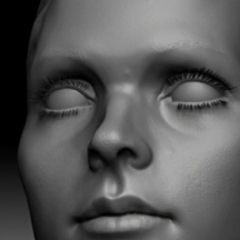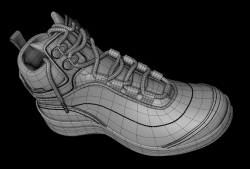-
Posts
3,798 -
Joined
-
Days Won
102
Content Type
Profiles
Blogs
Forums
Gallery
Pipeline Tools
3D Wiki
Plugin List
Store
Downloads
Everything posted by Rectro
-
-
Hi. Welcome to Core4D, you have come to the right place, loads of cool knowledgeable people here. Dan
-
Hi Dave, thanks for your reply. I had access to r21 again since writing this thread and tried to convert the materials using RS tools but that didn't work. I would assume saving materials library would just keep the node space the same which is not compatible with R20. What happens with the conversion is a material converts to a standard material only it cant be used, no nodes or parameters. The only way would have been for r21 and above to be able to converted RS node space back to xpresso Node space, but RS tools fail to do this. Your left with Xpresso material thats missing the nodes. Dan
-
Hi Peter, welcome to the Core. You have some very nice work on Artstation. Dan
-
Welcome to the forum. Nice works like the pearl bag looks great. As for aging, well let's say my first computer was a Sinclare Zx spectrum. 😊
-
Hello Rayhaan, welcome to Core4D. Look forward to seeing your progress and aspirations come to light. Dan
-
Hello, and welcome. All that you have learnt with photography will come into play, especially if you have a good understanding for vocal length, ISO, lighting, and framing a good shot. Producing a feature length without any help is a tall order depending on what is is, and how technical it is, but I like your ambition. Dan
-
Hi Bendik, welcome. We welcome your questions, and look forward to looking at your projects and art works. Dan
-
Welcome back, and thanks for posting this documentary, was really worth a watch. Dan
-
Hi. great work and welcome. Dan
-
Hi guys In a bit of a predicament as Im have to revert back to working back in R20 for now. The problem is my scenes have been made up from r21 or higher and no longer have access to these version. I loaded up a project I made for a client and realized Redshift Scene nodes are broken, they did not convert back to the standard node system prior to these changes. Not only has this messed up the textures and materials, but I have some more advanced set ups where displacements are driven by morphs. Is there a way I can convert these scenes to work in r20 in such cases as I cant do this with RS tools within R20? Thanks, Dan
-
Hi. You can get the hair to retain its shape by setting the Rest hold parameter. You can also get nice results from check boxing the Ridged all found in the dynamics properties. In the Dynamics/Advanced tab the iterations should be set to how many segments there are for the guides. Dan
-
Hello and welcome to core4d. Look forward to seeing what you produce next, great start. Dan
-
Awesome work mate, very inspiring. Dan
-
Not sure if your using a trial version or not but the release version now comes with different installers for each version of C4D, so for you, you chose the R20 installer. Once you install it, Ornatrix will have its own folder at the top of C4D UI. Dan
-
@HrvojeYou have done a great job, and I appreciate all your shared knowledge you have given over the years. I hope you stick around still. Dan
-
Congrats, can't think of anyone better, great guy, hardworking and gets things done. Dan
-
Looking great man, good to see you come back. I guess your going to rig her, or run her through Mixamo? Dan
-
Thank you Cata, I still have plenty of room for improvement, but the main thing is to keep enjoying it. As for as rigging goes, this area was out of my scope as I was modeling and sculpting, but while Im not the most technical rigger I did get to the point I can rig a character with controllers and deformers thanks to C4D intuitive methods of doing things. At the moment it can seem a bit intimidating but if you break things down into small chunks you will look back in a year from now and realize how simple it all was. Dan
-
Hi Cata, welcome to the Cafe. What area of C4D are you most interesting in to learn? Dan
-

Hello from Jake. Starting the steep C4D learning curve!
Rectro replied to JakS's topic in Introduction
Awesome, thanks Jake. Look forward to seeing your progress on your project. Dan -

Hello from Jake. Starting the steep C4D learning curve!
Rectro replied to JakS's topic in Introduction
Hi JAKS, welcome to the forum. Your first project looks like it coming on well. Can you check your profile please as C4D V6 is rather old now and doubt your using that version, this helps others know what tools you have in your version and limitations. Thanks, Dan -
This is a area Im still yet to look at . Its often the case that its user error and lack of knowledge and lack of knowledge is were I'd put myself regarding Ornatrix dynamics. Its the case that C4D hair dynamics works right off the bat as soon as you play the animation it drapes. I have read in V2 things have been improved so I will have a quick go again. The problem is in that very wording I guess "having a quick go" this is what I meant about hard to get predictable results, you can't get there quickly initially but the end results are better because Ornatrix deals with collisions much better, they have dedicated operators for collisions. Dan
-
Thats a good question, and your right there should be a good reason to justify a plugging in which is aimed at a feature set C4D has. I will address this in more detail in the video. What I can say on a simplified level for now is Ornatrix takes off where C4D hair system end in its abilities. This is mainly around control over particular guides, hair groups, its consistent interpolation methods, and its powerful modular approach. Modular: In C4D you have a single material with one set of attributes that change the outcome of the hair, these are called Operators within Ornatrix, lets take Frizz as an example. You can make and apply a map to control how much is applied and to where in C4D native hair system. This is also true with Ornatrix but things can taken much further. Due to Ornatrix modular methods you can apply as many operators as you wish in any order. A frizz operator is applied to the operator stack. like C4D it applies to the the entire hair. You may want one type of frizz on the top of the head, and another type on the sides. The only way to do this in C4D is to make multiple hair objects to have multiple materials. In ornatrix you can simply select the top of the hair guides, make it into a group, invert the selection make the group for the sides. Add two frizz operators and apply one to one group, and one to the other. No texture maps needed. What if within the settings of the frizz you wanted some hairs to receive more frizz not just the full length but just at the tips of the length? This can not be done in C4D, its all or nothing. You can use texture maps for the entire length in C4D but not on a per vertex level. With Ornatrix not only can you assign a group such as the top of the hair only, but within that group you can assign particular guides to receive more or less frizz, again no texture maps needed. These are called channels and can be painted with a vertex brush directly on the guides, or flood filled either as a value between 0 = Back to 1 White and all values between. You can make as many Channels as you wish either on a per strand basis or a per vertex basis. If you use a per strand basis the assigned value applies to the whole guide. A value of 1 would get 100% frizz, 0.5 = 50% all the way down to 0 no frizz at all. If you make a channel on a vertex basis you can brush with the vertex brush tool any value you wish down the length of the guide. This lets you apply frizz right at the tips for example. Not only do you get this additional control but no texture maps are needed. You can have has many frizz operators as you wish, this applies to all operators in which some operators gives you control on not just the amount but other attributes. Clumping: Clumping is essential to get realistic looking hair or fur, C4D clumping abilities are not only limited but very hard to use. In reality there are multiple layers of clumping from larger clumps to very fine layers. C4D only allows you to add one layer. With Ornatrix you can add multiple clump operators each one can take the last into account to further split larger clumps into smaller ones. You can again choose a group of guides, and particular channels for individual guides. Where Ornatrix takes things to a whole level higher is you can choose individual hairs and clump them, or remove clumping, or edit individual clump sets. You have so much control over clumping that C4D does not. Direct Hair grooming: You can make your groom using guides, add multiple operators to fine tune it, then actually groom the hair directly. This means you can use all the brushes directly on the hair itself. Bake operators to your guides: You can force certain operators to be baked to the actual guides, this means you can remove them operators which makes simulations for example faster. Remember you can apply operators to both the hairs or directly to the guides. Interpolation: The interpolation for how the the hair responds to the guides is essential for a good outcome. C4D is lacking in this area. Ornatrix really shines here. Some styles need different interpolations and Ornatrix gets you so close to the style your making with the guides. Other mentions: The Surface Come tool lets you draw arrows in the direction you wish the hair to flow. v2 has made this even better but C4D does not have this feature. This is especially useful for animals, but can be used on human hair. Push Away From Surface will push your hair away from the head, this is a one click fix for intersections. It works and works well. You have further operators to help add additional details such as more verts to certain strands, smoothing, collision prevention. You can save hair styles for later use, export for Unreal. These are just a few things to mention. The outcome is that you get the hair under control spot on to how you want it. Dan
-
Yes I will do that. A introduction to Ornatrix. That will help me get back into the swing of things. Dan


